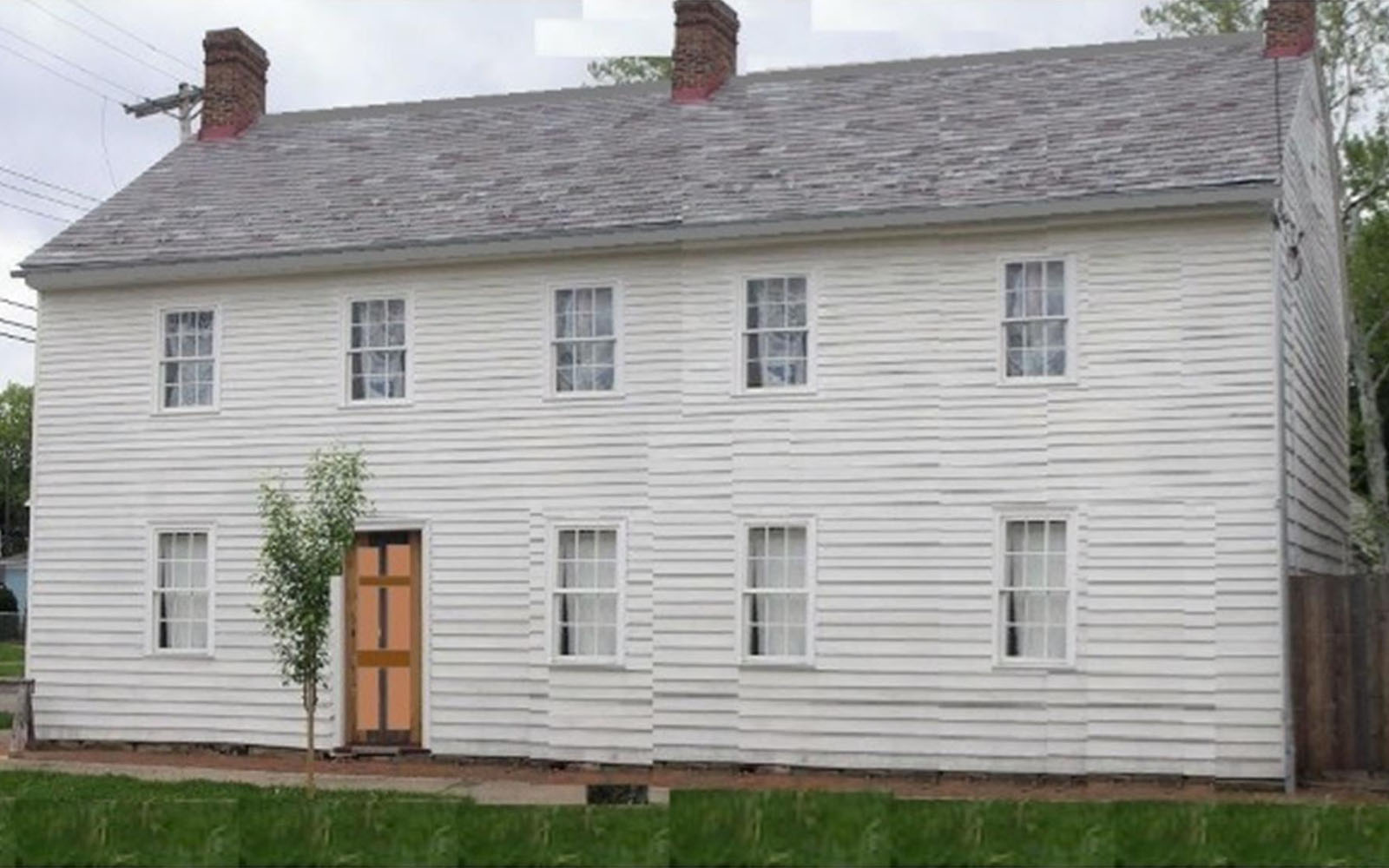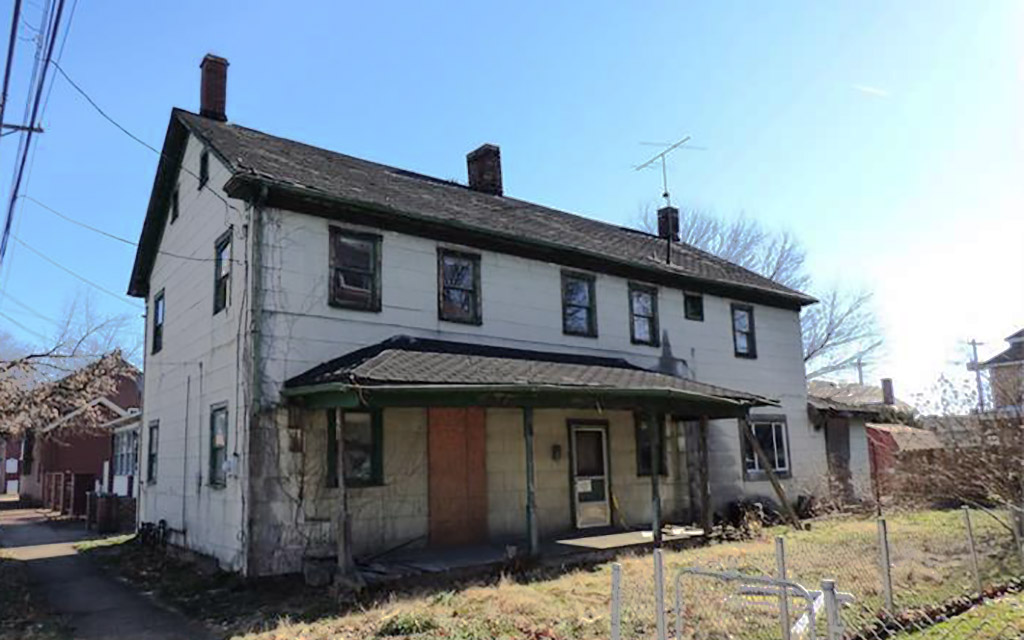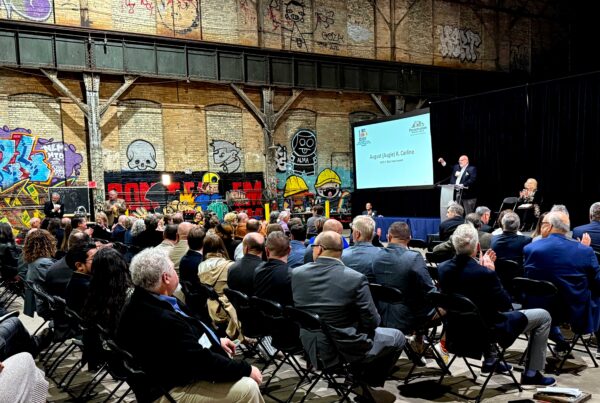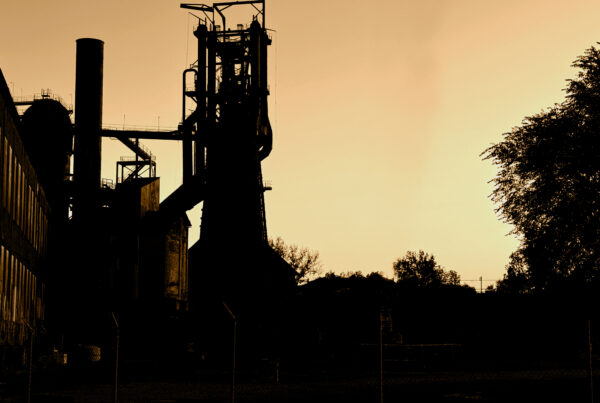
An early rendering of the Bicentennial House by Cochran Associates Architects. Courtesy of AHEDEC.
Community Spotlight
The Community Spotlight series features the efforts Rivers of Steel’s partner organizations, along with collaborative partnerships, that reflect the diversity and vibrancy of the communities within the Rivers of Steel National Heritage Area.
By Gita Michulka, Contributing Writer
 The Ambridge Bicentennial House: A Community Preservation Project
The Ambridge Bicentennial House: A Community Preservation Project
A historic building nearly condemned to demolition is now on the path to preservation. Located at 284 13th Street in Ambridge, Pennsylvania, the almost two-hundred-year-old house is one of the earliest residential Harmonist buildings, part of a religious community built on the banks of the Ohio River north of Pittsburgh. Dubbed the Bicentennial House, the structure is now a registered National Historic Landmark and is listed on the National Register of Historic Places.
“Looking into the Bicentennial House, what we’ve determined from digging out records that are housed at Old Economy Village, we found that it was built in the summer of 1824 and is one of the Harmonist’s first six buildings,” says Carl Sutherland, project coordinator for the restoration project. “We don’t know if it’s the first or the sixth, but it was built to house the advance group of Harmonists, the carpenters and masons and finishers who were the first people to land to build structures for the rest of the party as they came to Ökonomie (now Ambridge).”

The Bicentennial House before work began. The building was dubbed the Bicentennial House by the Ambridge Historic District Economic Development Corporation in celebration of the 200-year anniversary of the Harmonist village in Ambridge that will occur in 2024. Courtesy of AHEDEC.
Sutherland is a key member of the Ambridge Historic District Economic Development Corporation (AHDEDC), a nonprofit whose mission is promoting the district and its economic viability, along with Steve Roberts, chair of AHDEDC, and Michael Knecht, AHDEDC board member and site administrator at Old Economy Village. A combination of their efforts can be credited for bringing this project to life.
“I guess you could say it’s my fault,” says Roberts, laughing. After working for years on revitalizing the Mexican War Street houses in Pittsburgh’s North Side, Roberts made the move to Ambridge, to a log cabin across the street from the Bicentennial House.
“When I came here, I saw this Harmonist house that most of the street said, ‘I wish they’d tear that down’,” notes Roberts, who is also a realter with Keller Williams. “It was just sitting empty. I looked it up and found out that it was owned by somebody out of state that had bought it at a tax sale. And I talked her into listing it and putting a sign up. And gradually that sort of started to change people’s minds—if something had value to sell, then maybe it’s, you know, something different.”
As time passed and no offers came in to purchase the home, Roberts began urging the other members of AHDEDC to take on the project. His efforts paid off, and the owner of the home agreed to donate it to the organization.
Momentum for preserving this piece of the community’s history grew from there. After Preservation Pennsylvania designated it as one of the seven most important historic buildings “at risk” in Pennsylvania, they granted AHDEDC $5,000 to have a feasibility study prepared. This allowed the group to then pursue additional funding.
In 2021 the organization was awarded funding through Rivers of Steel’s Mini-Grant Program to secure the building and remove exterior hazards, including a collapsing porch and rear addition. The grant allowed for in-kind volunteer hours as part of the required match, which Sutherland notes was critical to their progress.
“The one thing that’s wonderful about the Rivers of Steel grant is that inclusion of in-kind labor. We’ve got a lot of volunteer labor that can be utilized,” he notes. “We needed so many hours against the grant—we’re approaching double that at this point.”
“Carl has really worked hard to stabilize this building,” continues Roberts. “He’s done everything from coordinating weekly ‘work parties’ to unifying the volunteers, to literally cutting down trees and planing them to make the right-sized beam to go under part of [the house] that needed to be jacked up. We’re a small group, but it’s pretty cool to be doing this kind of work and seeing the progress.”

Volunteers were essential in helping to complete the early stages of the work. Courtesy of AHEDEC.
The completion of the work funded by Rivers of Steel then led to a Keystone Historic Preservation Planning Grant, which the organization utilized to hire MCF Architects to develop final plan options and create specifications for restoration and renovation. These plans will allow AHDEDC to solicit bids to complete the work while simultaneously pursuing a larger fundraising campaign, both next steps on the path to a 2024 bicentennial celebration of the house and the Ambridge Historic District.
Additional funding and partners will be sought to finish the structural stabilization, restore the exterior of the house, complete the interior renovations, and finally to develop programming for its use. As they work through this list, Roberts hopes they can continue to grow momentum, both for this project and other community development projects in the area.
“I came from Pittsburgh and was involved with a community development corporation (CDC) And Pittsburgh was well supported with CDCs all over, in every neighborhood, that were funded through both the foundations and the Urban Redevelopment Authority, and they made a huge difference because they took on buildings and they redid them,” says Roberts. “A lot of that just doesn’t exist out here in Beaver County. The support we’ve gotten from Preservation Pennsylvania and Rivers of Steel is really sort of cracking a door open, because it’s something that really hasn’t been done.”
Knecht, who has also been involved with the project since the beginning, wholeheartedly agrees. “The Rivers of Steel grant was a major shot in the arm and boost to the entire project. The work that we’ve been able to accomplish with those funds really has raised awareness of the project in the community. They see work going on as a result of the grant, and it definitely has people talking about what’s going on with the house and asking what are your next steps and things like that.”
“We felt it was critical to show the community how, through creative partnerships and fundraising, and hard work and elbow grease, you can bring a house like this back to life and give it new meaning for hopefully another 200 years,” Knecht continues.

A new sign is displayed onsite detailing the historic designations and the work that is ongoing.
As they near this celebration of 200 years of history, Roberts sees potential for the future of the Ambridge Historic District. “Part of the whole point of all of this, in little towns like this that have hit sort of rock bottom after all the steel mills left, is a revitalization. And finding some hook that gets them to be a destination point. Old Economy Museum is not large enough by itself, because you really want a walking area and shops to go to, and so getting beyond that and making the whole area of the historic district a destination point, then it makes Ambridge more of a destination point.”
“Our little step on the Bicentennial House, and support for it from funding partners like Rivers of Steel, is really sort of an eye opener in a way, of what we need to do or maybe do on a bigger scale,” he continues. “So that we just don’t sit here and wait for things to happen or fall down or get torn down, but to actually make a difference.”
To learn more about the Ambridge Historic District and the Bicentennial House, visit ambridgehistoricdistrict.org or follow Ambridge Historic District Economic Development Corporation on Facebook.
About the Mini-Grant Program
Rivers of Steel’s Mini-Grant Program assists heritage-related sites and organizations as well as municipalities within the Rivers of Steel National Heritage Area to develop new and innovative programs, partnerships, exhibits, tours, and other initiatives. Funded projects support heritage tourism, enhance preservation efforts, involve the stewardship of natural resources, encourage outdoor recreation, and include collaborative partnerships. Through these efforts, Rivers of Steel seeks to identify, conserve, promote, and interpret the industrial and cultural heritage that defines southwestern Pennsylvania.
The Rivers of Steel National Heritage Area is one of twelve supported by the Pennsylvania Department of Conservation and Natural Resources (DCNR). Funding is provided via DCNR’s Community Conservation Partnerships Program and the Environmental Stewardship Fund to Rivers of Steel, which administers the Mini-Grant Program. The Ambridge Historic District is one of six organizations who received Mini-Grant funding through this program in 2021.
Gita Michulka is a Pittsburgh-based marketing and communications consultant with over 15 years of experience promoting our region’s arts, recreation, and nonprofit assets.
If you’d like to know more about community projects supported by the Mini-Grant Program, read Gita’s recent article about the Josh Gibson Foundation’s collaboration with local teens to create an educational app.

 The Ambridge Bicentennial House: A Community Preservation Project
The Ambridge Bicentennial House: A Community Preservation Project





